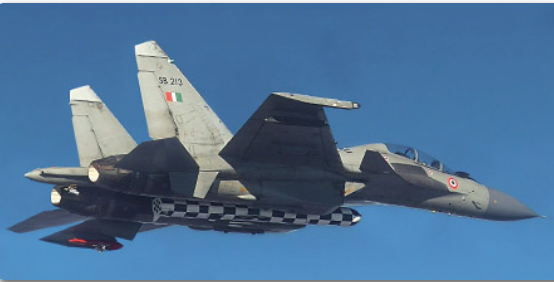Meet Brahmos, Akashteer, Su-30MKI, Barak 8, LR SAM and S-400: India’s Impenetrable Wall in Operation Sindoor

On May 7, 2025, the Indian Air Force launched Operation Sindoor, a decisive military campaign targeting terrorist strongholds and strategic military infrastructure in Pakistan and Pakistan-Occupied Kashmir. Triggered by the Pahalgam terror attack and escalating India-Pakistan conflict, this operation showcased India’s advanced air warfare capabilities through a combination of indigenous defense systems and co-developed military technology. The synergy of the BrahMos missile, Sukhoi Su-30MKI, Akashteer, Barak-8, S-400, and the IACCS enabled India to deliver precision strikes while maintaining an impenetrable air defense, redefining its strategic posture against nuclear deterrence threats.
Offensive Power: BrahMos and Sukhoi Su-30MKI
BrahMos Supersonic Missile: The Spear of Precision
The BrahMos missile, a cornerstone of India’s military technology, led the offensive during Operation Sindoor. This supersonic missile, developed in collaboration with Russia, struck key Pakistani targets, including the Noor Khan and Sargodha airbases, with unparalleled precision strikes. Achieving a circular error probability (CEP) of less than one meter, the BrahMos devastated runways, bunkers, and command centers on May 10. Its ability to travel at Mach 3 and follow a low-altitude, sea-skimming trajectory allowed it to evade Pakistan’s air defense systems.
The BrahMos missile’s multi-platform versatility—deployable from land, sea, air, and submarines—proved critical. Launched from Sukhoi Su-30MKI jets, it extended India’s strike range to 300–600 km, enabling deep penetration into enemy territory while minimizing risks to pilots. Carrying a 200–300 kg warhead, the BrahMos targeted hardened infrastructure, including suspected nuclear deterrence facilities, underscoring its strategic impact.
Sukhoi Su-30MKI: The Aerial Force Multiplier
The Sukhoi Su-30MKI, manufactured by Hindustan Aeronautics Limited, was the backbone of the Indian Air Force’s offensive operations. These multirole fighters, equipped to carry a single 2.5-ton BrahMos missile, functioned as precision strike platforms during Operation Sindoor. Striking targets like the Noor Khan airbase, the Sukhoi Su-30MKI leveraged its advanced avionics and extended range—up to 11 hours with mid-air refueling—to deliver devastating blows from safe distances.
The integration of the BrahMos with the Sukhoi Su-30MKI enhanced India’s air warfare capabilities, allowing the Indian Air Force to project power deep into Pakistani territory. This combination overwhelmed enemy defenses, showcasing India’s ability to conduct high-impact precision strikes in the India-Pakistan conflict.
Defensive Strength: Akashteer, Barak-8, and S-400
Akashteer: India’s Indigenous Air Defense Shield
The Akashteer system, particularly its advanced Akash NG variant, was the cornerstone of India’s air defense strategy. This fully indigenous defense system intercepted Pakistani drones and missiles during Operation Sindoor, protecting military and civilian assets. With engagement speeds of Mach 2.5 and a range covering altitudes from 30 meters to 20 kilometers, Akashteer neutralized multiple threats, including drone swarms, with precision. Its domestically developed radar and command systems highlighted India’s progress in military technology and self-reliance.
Barak-8 and S-400: A Multi-Layered Defense
The Barak-8, co-developed with Israel, strengthened India’s air defense network. Its advanced radar and missile guidance systems countered Pakistani rockets and drones, ensuring minimal damage from retaliatory strikes. Complementing it was the Russian S-400, a long-range air defense system that intercepted high-altitude threats, creating a robust shield alongside Akashteer and Barak-8. Together, these systems safeguarded India’s airspace during the intense India-Pakistan conflict.
Coordination: The Role of IACCS
The Integrated Air Command and Control System (IACCS), an indigenous defense platform, was pivotal in orchestrating Operation Sindoor. By integrating data from radars, sensors, and AWACS, the IACCS provided real-time situational awareness, enabling seamless coordination between offensive and defensive operations. This ensured that every threat was detected and neutralized swiftly, enhancing the Indian Air Force’s effectiveness in air warfare.
Strategic Outcome
Operation Sindoor demonstrated India’s mastery of air warfare through the integration of BrahMos, Sukhoi Su-30MKI, Akashteer, Barak-8, S-400, and IACCS. The operation dismantled Pakistan’s terrorist and military infrastructure, including critical nodes like the Nur Khan airbase, while countering nuclear deterrence threats. This marked a shift from strategic restraint to assertive retaliation, redefining the India-Pakistan conflict dynamics.
India’s reliance on indigenous defense systems like Akashteer and IACCS, combined with co-developed military technology like BrahMos and Barak-8, underscored its technological prowess. Operation Sindoor not only achieved tactical success but also established India as a formidable force in modern air warfare.